Report on Exploring the Paradigms of War
VerifiedAdded on 2020/05/01
|10
|2830
|39
AI Summary
Contribute Materials
Your contribution can guide someone’s learning journey. Share your
documents today.
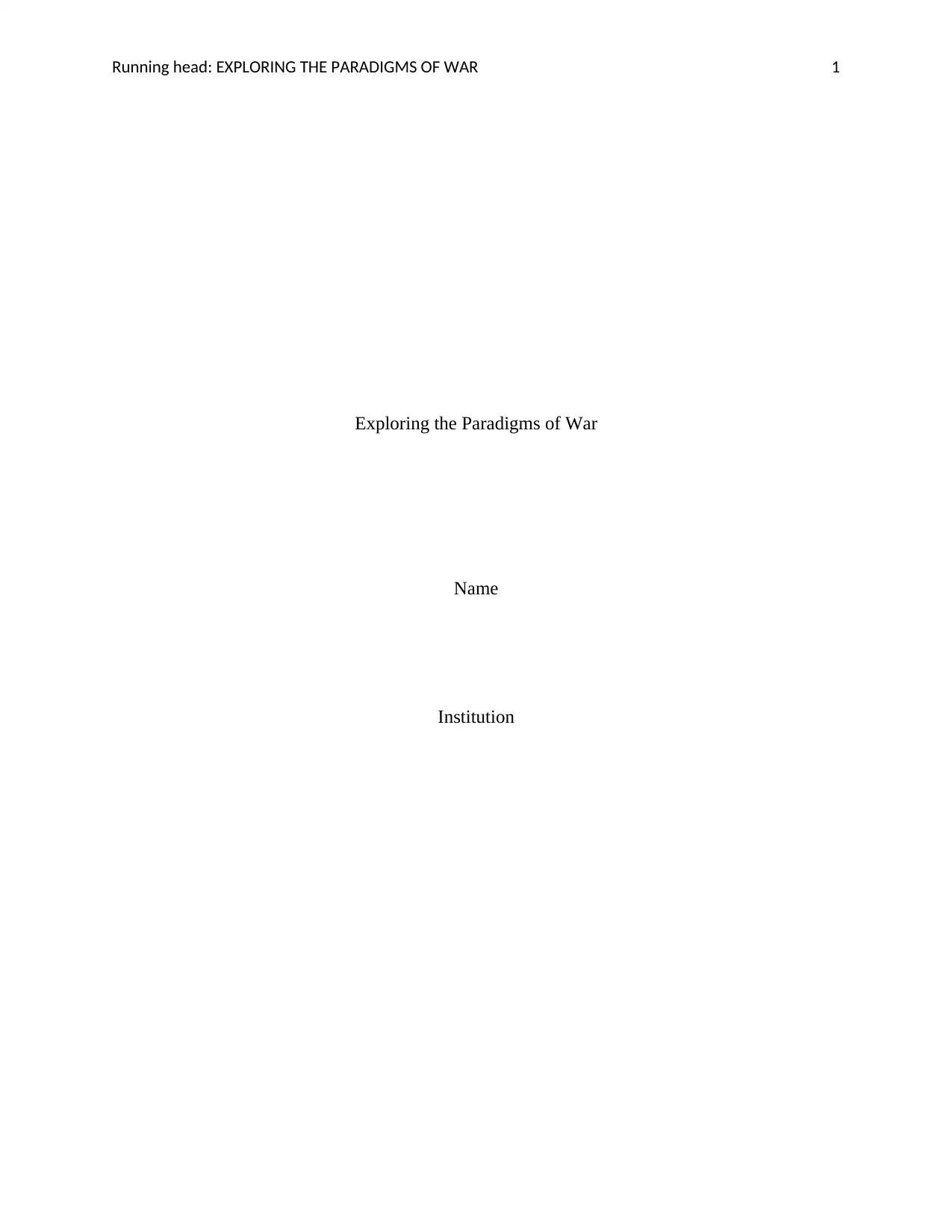
Running head: EXPLORING THE PARADIGMS OF WAR 1
Exploring the Paradigms of War
Name
Institution
Exploring the Paradigms of War
Name
Institution
Secure Best Marks with AI Grader
Need help grading? Try our AI Grader for instant feedback on your assignments.
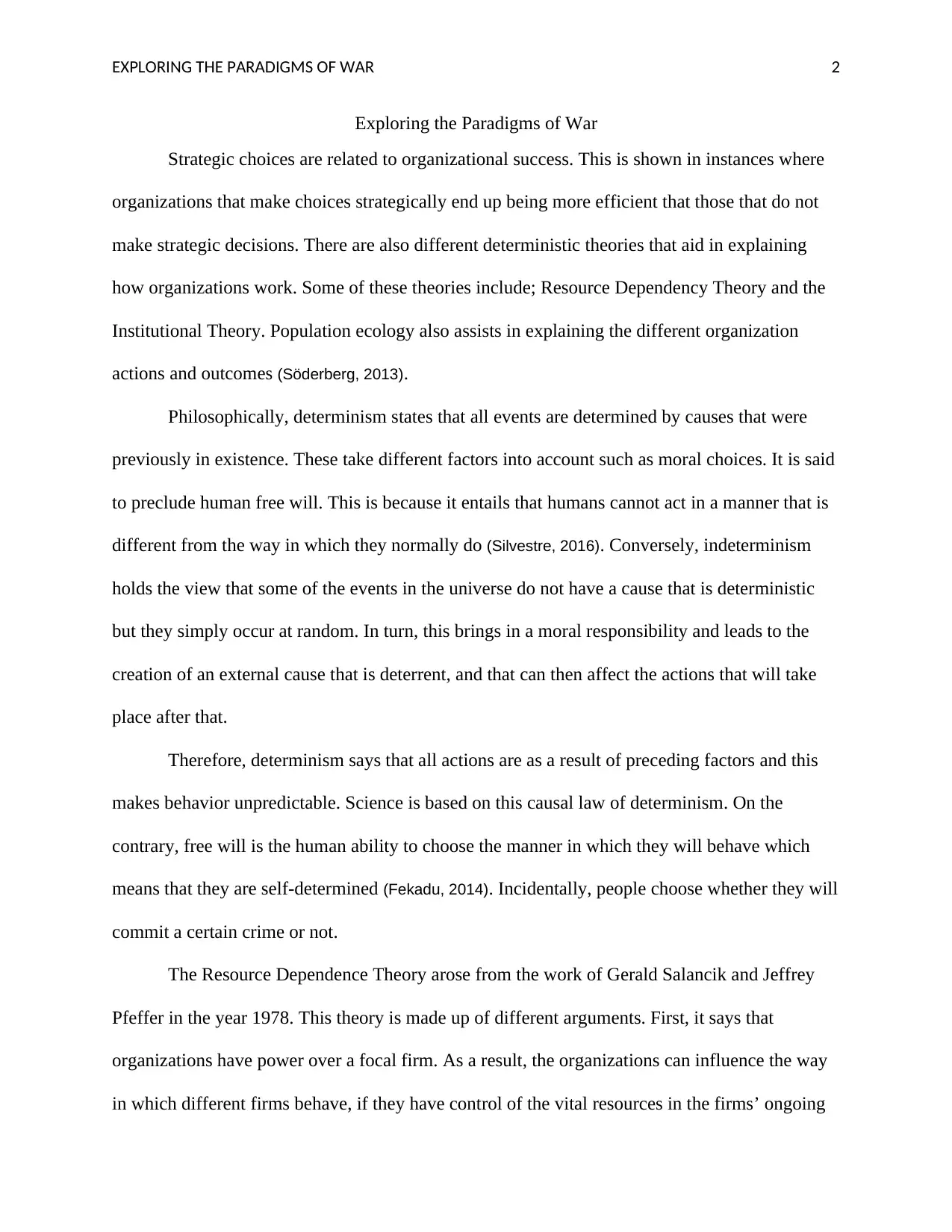
EXPLORING THE PARADIGMS OF WAR 2
Exploring the Paradigms of War
Strategic choices are related to organizational success. This is shown in instances where
organizations that make choices strategically end up being more efficient that those that do not
make strategic decisions. There are also different deterministic theories that aid in explaining
how organizations work. Some of these theories include; Resource Dependency Theory and the
Institutional Theory. Population ecology also assists in explaining the different organization
actions and outcomes (Söderberg, 2013).
Philosophically, determinism states that all events are determined by causes that were
previously in existence. These take different factors into account such as moral choices. It is said
to preclude human free will. This is because it entails that humans cannot act in a manner that is
different from the way in which they normally do (Silvestre, 2016). Conversely, indeterminism
holds the view that some of the events in the universe do not have a cause that is deterministic
but they simply occur at random. In turn, this brings in a moral responsibility and leads to the
creation of an external cause that is deterrent, and that can then affect the actions that will take
place after that.
Therefore, determinism says that all actions are as a result of preceding factors and this
makes behavior unpredictable. Science is based on this causal law of determinism. On the
contrary, free will is the human ability to choose the manner in which they will behave which
means that they are self-determined (Fekadu, 2014). Incidentally, people choose whether they will
commit a certain crime or not.
The Resource Dependence Theory arose from the work of Gerald Salancik and Jeffrey
Pfeffer in the year 1978. This theory is made up of different arguments. First, it says that
organizations have power over a focal firm. As a result, the organizations can influence the way
in which different firms behave, if they have control of the vital resources in the firms’ ongoing
Exploring the Paradigms of War
Strategic choices are related to organizational success. This is shown in instances where
organizations that make choices strategically end up being more efficient that those that do not
make strategic decisions. There are also different deterministic theories that aid in explaining
how organizations work. Some of these theories include; Resource Dependency Theory and the
Institutional Theory. Population ecology also assists in explaining the different organization
actions and outcomes (Söderberg, 2013).
Philosophically, determinism states that all events are determined by causes that were
previously in existence. These take different factors into account such as moral choices. It is said
to preclude human free will. This is because it entails that humans cannot act in a manner that is
different from the way in which they normally do (Silvestre, 2016). Conversely, indeterminism
holds the view that some of the events in the universe do not have a cause that is deterministic
but they simply occur at random. In turn, this brings in a moral responsibility and leads to the
creation of an external cause that is deterrent, and that can then affect the actions that will take
place after that.
Therefore, determinism says that all actions are as a result of preceding factors and this
makes behavior unpredictable. Science is based on this causal law of determinism. On the
contrary, free will is the human ability to choose the manner in which they will behave which
means that they are self-determined (Fekadu, 2014). Incidentally, people choose whether they will
commit a certain crime or not.
The Resource Dependence Theory arose from the work of Gerald Salancik and Jeffrey
Pfeffer in the year 1978. This theory is made up of different arguments. First, it says that
organizations have power over a focal firm. As a result, the organizations can influence the way
in which different firms behave, if they have control of the vital resources in the firms’ ongoing
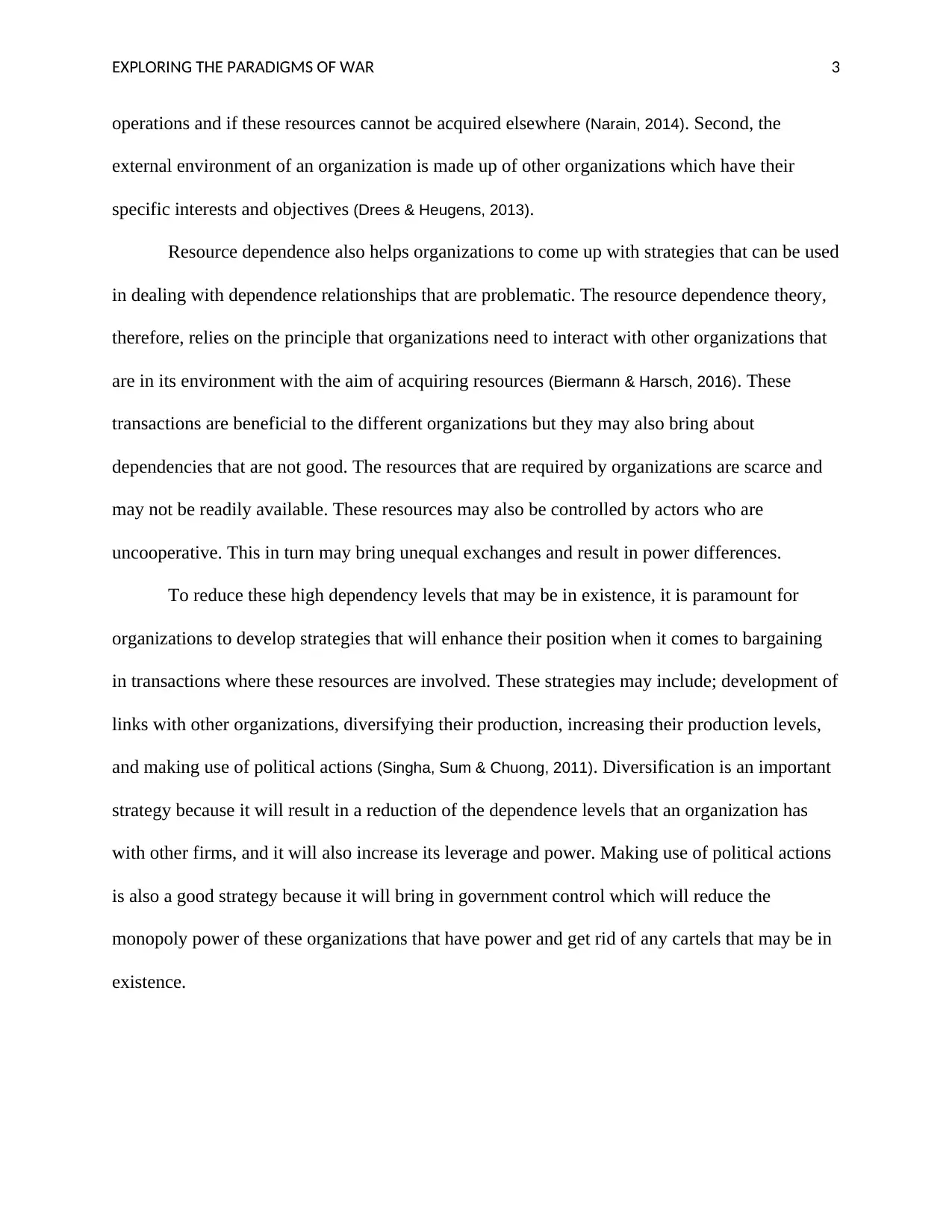
EXPLORING THE PARADIGMS OF WAR 3
operations and if these resources cannot be acquired elsewhere (Narain, 2014). Second, the
external environment of an organization is made up of other organizations which have their
specific interests and objectives (Drees & Heugens, 2013).
Resource dependence also helps organizations to come up with strategies that can be used
in dealing with dependence relationships that are problematic. The resource dependence theory,
therefore, relies on the principle that organizations need to interact with other organizations that
are in its environment with the aim of acquiring resources (Biermann & Harsch, 2016). These
transactions are beneficial to the different organizations but they may also bring about
dependencies that are not good. The resources that are required by organizations are scarce and
may not be readily available. These resources may also be controlled by actors who are
uncooperative. This in turn may bring unequal exchanges and result in power differences.
To reduce these high dependency levels that may be in existence, it is paramount for
organizations to develop strategies that will enhance their position when it comes to bargaining
in transactions where these resources are involved. These strategies may include; development of
links with other organizations, diversifying their production, increasing their production levels,
and making use of political actions (Singha, Sum & Chuong, 2011). Diversification is an important
strategy because it will result in a reduction of the dependence levels that an organization has
with other firms, and it will also increase its leverage and power. Making use of political actions
is also a good strategy because it will bring in government control which will reduce the
monopoly power of these organizations that have power and get rid of any cartels that may be in
existence.
operations and if these resources cannot be acquired elsewhere (Narain, 2014). Second, the
external environment of an organization is made up of other organizations which have their
specific interests and objectives (Drees & Heugens, 2013).
Resource dependence also helps organizations to come up with strategies that can be used
in dealing with dependence relationships that are problematic. The resource dependence theory,
therefore, relies on the principle that organizations need to interact with other organizations that
are in its environment with the aim of acquiring resources (Biermann & Harsch, 2016). These
transactions are beneficial to the different organizations but they may also bring about
dependencies that are not good. The resources that are required by organizations are scarce and
may not be readily available. These resources may also be controlled by actors who are
uncooperative. This in turn may bring unequal exchanges and result in power differences.
To reduce these high dependency levels that may be in existence, it is paramount for
organizations to develop strategies that will enhance their position when it comes to bargaining
in transactions where these resources are involved. These strategies may include; development of
links with other organizations, diversifying their production, increasing their production levels,
and making use of political actions (Singha, Sum & Chuong, 2011). Diversification is an important
strategy because it will result in a reduction of the dependence levels that an organization has
with other firms, and it will also increase its leverage and power. Making use of political actions
is also a good strategy because it will bring in government control which will reduce the
monopoly power of these organizations that have power and get rid of any cartels that may be in
existence.
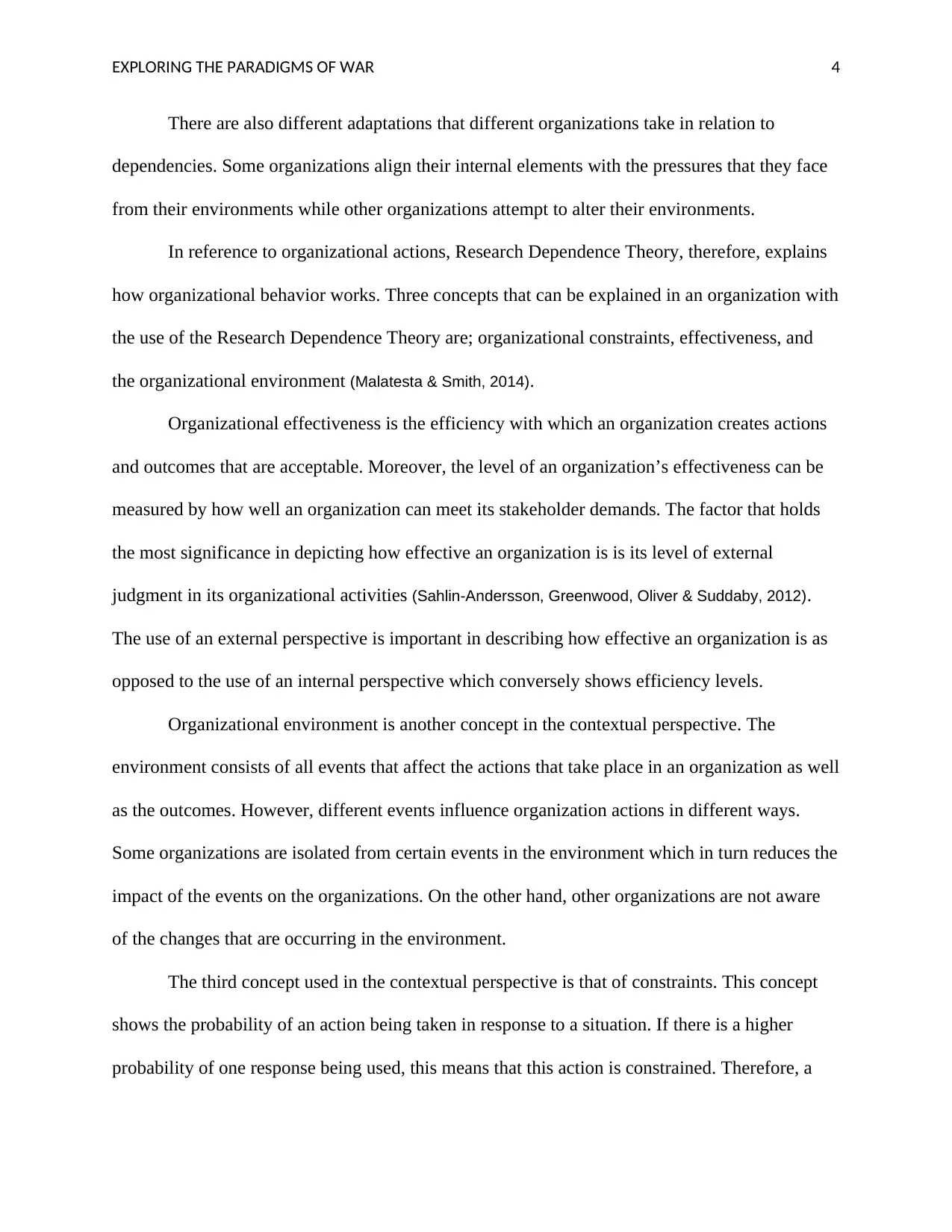
EXPLORING THE PARADIGMS OF WAR 4
There are also different adaptations that different organizations take in relation to
dependencies. Some organizations align their internal elements with the pressures that they face
from their environments while other organizations attempt to alter their environments.
In reference to organizational actions, Research Dependence Theory, therefore, explains
how organizational behavior works. Three concepts that can be explained in an organization with
the use of the Research Dependence Theory are; organizational constraints, effectiveness, and
the organizational environment (Malatesta & Smith, 2014).
Organizational effectiveness is the efficiency with which an organization creates actions
and outcomes that are acceptable. Moreover, the level of an organization’s effectiveness can be
measured by how well an organization can meet its stakeholder demands. The factor that holds
the most significance in depicting how effective an organization is is its level of external
judgment in its organizational activities (Sahlin-Andersson, Greenwood, Oliver & Suddaby, 2012).
The use of an external perspective is important in describing how effective an organization is as
opposed to the use of an internal perspective which conversely shows efficiency levels.
Organizational environment is another concept in the contextual perspective. The
environment consists of all events that affect the actions that take place in an organization as well
as the outcomes. However, different events influence organization actions in different ways.
Some organizations are isolated from certain events in the environment which in turn reduces the
impact of the events on the organizations. On the other hand, other organizations are not aware
of the changes that are occurring in the environment.
The third concept used in the contextual perspective is that of constraints. This concept
shows the probability of an action being taken in response to a situation. If there is a higher
probability of one response being used, this means that this action is constrained. Therefore, a
There are also different adaptations that different organizations take in relation to
dependencies. Some organizations align their internal elements with the pressures that they face
from their environments while other organizations attempt to alter their environments.
In reference to organizational actions, Research Dependence Theory, therefore, explains
how organizational behavior works. Three concepts that can be explained in an organization with
the use of the Research Dependence Theory are; organizational constraints, effectiveness, and
the organizational environment (Malatesta & Smith, 2014).
Organizational effectiveness is the efficiency with which an organization creates actions
and outcomes that are acceptable. Moreover, the level of an organization’s effectiveness can be
measured by how well an organization can meet its stakeholder demands. The factor that holds
the most significance in depicting how effective an organization is is its level of external
judgment in its organizational activities (Sahlin-Andersson, Greenwood, Oliver & Suddaby, 2012).
The use of an external perspective is important in describing how effective an organization is as
opposed to the use of an internal perspective which conversely shows efficiency levels.
Organizational environment is another concept in the contextual perspective. The
environment consists of all events that affect the actions that take place in an organization as well
as the outcomes. However, different events influence organization actions in different ways.
Some organizations are isolated from certain events in the environment which in turn reduces the
impact of the events on the organizations. On the other hand, other organizations are not aware
of the changes that are occurring in the environment.
The third concept used in the contextual perspective is that of constraints. This concept
shows the probability of an action being taken in response to a situation. If there is a higher
probability of one response being used, this means that this action is constrained. Therefore, a
Secure Best Marks with AI Grader
Need help grading? Try our AI Grader for instant feedback on your assignments.
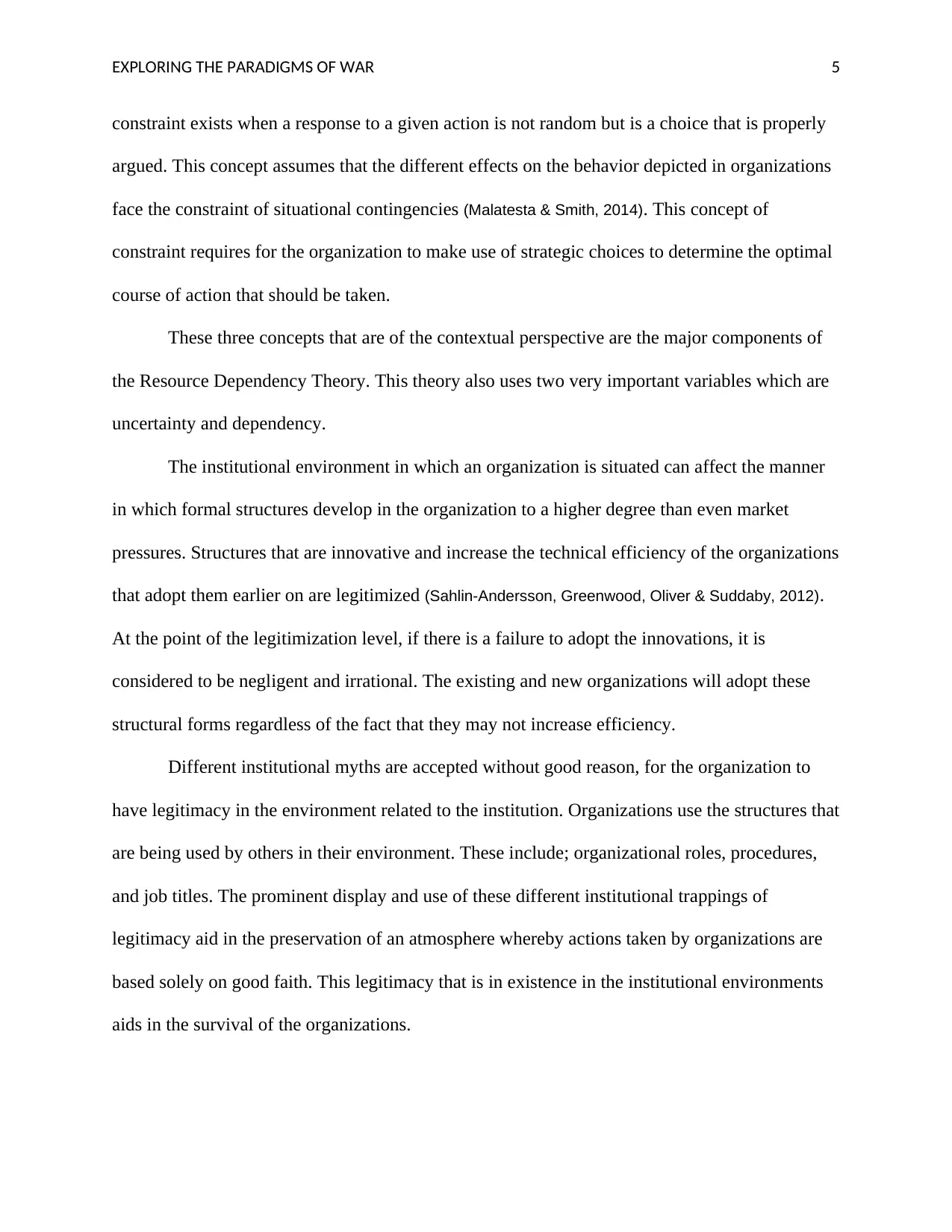
EXPLORING THE PARADIGMS OF WAR 5
constraint exists when a response to a given action is not random but is a choice that is properly
argued. This concept assumes that the different effects on the behavior depicted in organizations
face the constraint of situational contingencies (Malatesta & Smith, 2014). This concept of
constraint requires for the organization to make use of strategic choices to determine the optimal
course of action that should be taken.
These three concepts that are of the contextual perspective are the major components of
the Resource Dependency Theory. This theory also uses two very important variables which are
uncertainty and dependency.
The institutional environment in which an organization is situated can affect the manner
in which formal structures develop in the organization to a higher degree than even market
pressures. Structures that are innovative and increase the technical efficiency of the organizations
that adopt them earlier on are legitimized (Sahlin-Andersson, Greenwood, Oliver & Suddaby, 2012).
At the point of the legitimization level, if there is a failure to adopt the innovations, it is
considered to be negligent and irrational. The existing and new organizations will adopt these
structural forms regardless of the fact that they may not increase efficiency.
Different institutional myths are accepted without good reason, for the organization to
have legitimacy in the environment related to the institution. Organizations use the structures that
are being used by others in their environment. These include; organizational roles, procedures,
and job titles. The prominent display and use of these different institutional trappings of
legitimacy aid in the preservation of an atmosphere whereby actions taken by organizations are
based solely on good faith. This legitimacy that is in existence in the institutional environments
aids in the survival of the organizations.
constraint exists when a response to a given action is not random but is a choice that is properly
argued. This concept assumes that the different effects on the behavior depicted in organizations
face the constraint of situational contingencies (Malatesta & Smith, 2014). This concept of
constraint requires for the organization to make use of strategic choices to determine the optimal
course of action that should be taken.
These three concepts that are of the contextual perspective are the major components of
the Resource Dependency Theory. This theory also uses two very important variables which are
uncertainty and dependency.
The institutional environment in which an organization is situated can affect the manner
in which formal structures develop in the organization to a higher degree than even market
pressures. Structures that are innovative and increase the technical efficiency of the organizations
that adopt them earlier on are legitimized (Sahlin-Andersson, Greenwood, Oliver & Suddaby, 2012).
At the point of the legitimization level, if there is a failure to adopt the innovations, it is
considered to be negligent and irrational. The existing and new organizations will adopt these
structural forms regardless of the fact that they may not increase efficiency.
Different institutional myths are accepted without good reason, for the organization to
have legitimacy in the environment related to the institution. Organizations use the structures that
are being used by others in their environment. These include; organizational roles, procedures,
and job titles. The prominent display and use of these different institutional trappings of
legitimacy aid in the preservation of an atmosphere whereby actions taken by organizations are
based solely on good faith. This legitimacy that is in existence in the institutional environments
aids in the survival of the organizations.
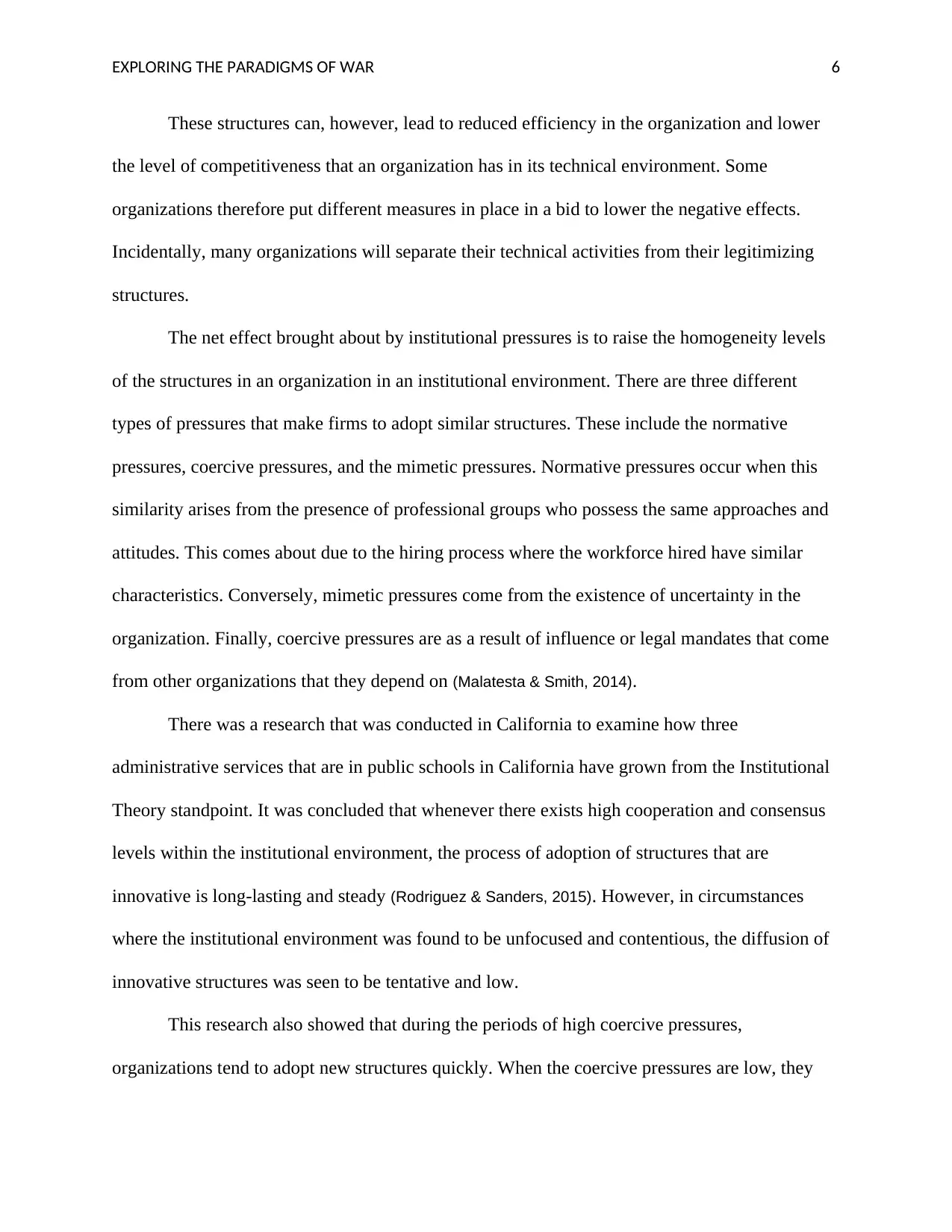
EXPLORING THE PARADIGMS OF WAR 6
These structures can, however, lead to reduced efficiency in the organization and lower
the level of competitiveness that an organization has in its technical environment. Some
organizations therefore put different measures in place in a bid to lower the negative effects.
Incidentally, many organizations will separate their technical activities from their legitimizing
structures.
The net effect brought about by institutional pressures is to raise the homogeneity levels
of the structures in an organization in an institutional environment. There are three different
types of pressures that make firms to adopt similar structures. These include the normative
pressures, coercive pressures, and the mimetic pressures. Normative pressures occur when this
similarity arises from the presence of professional groups who possess the same approaches and
attitudes. This comes about due to the hiring process where the workforce hired have similar
characteristics. Conversely, mimetic pressures come from the existence of uncertainty in the
organization. Finally, coercive pressures are as a result of influence or legal mandates that come
from other organizations that they depend on (Malatesta & Smith, 2014).
There was a research that was conducted in California to examine how three
administrative services that are in public schools in California have grown from the Institutional
Theory standpoint. It was concluded that whenever there exists high cooperation and consensus
levels within the institutional environment, the process of adoption of structures that are
innovative is long-lasting and steady (Rodriguez & Sanders, 2015). However, in circumstances
where the institutional environment was found to be unfocused and contentious, the diffusion of
innovative structures was seen to be tentative and low.
This research also showed that during the periods of high coercive pressures,
organizations tend to adopt new structures quickly. When the coercive pressures are low, they
These structures can, however, lead to reduced efficiency in the organization and lower
the level of competitiveness that an organization has in its technical environment. Some
organizations therefore put different measures in place in a bid to lower the negative effects.
Incidentally, many organizations will separate their technical activities from their legitimizing
structures.
The net effect brought about by institutional pressures is to raise the homogeneity levels
of the structures in an organization in an institutional environment. There are three different
types of pressures that make firms to adopt similar structures. These include the normative
pressures, coercive pressures, and the mimetic pressures. Normative pressures occur when this
similarity arises from the presence of professional groups who possess the same approaches and
attitudes. This comes about due to the hiring process where the workforce hired have similar
characteristics. Conversely, mimetic pressures come from the existence of uncertainty in the
organization. Finally, coercive pressures are as a result of influence or legal mandates that come
from other organizations that they depend on (Malatesta & Smith, 2014).
There was a research that was conducted in California to examine how three
administrative services that are in public schools in California have grown from the Institutional
Theory standpoint. It was concluded that whenever there exists high cooperation and consensus
levels within the institutional environment, the process of adoption of structures that are
innovative is long-lasting and steady (Rodriguez & Sanders, 2015). However, in circumstances
where the institutional environment was found to be unfocused and contentious, the diffusion of
innovative structures was seen to be tentative and low.
This research also showed that during the periods of high coercive pressures,
organizations tend to adopt new structures quickly. When the coercive pressures are low, they
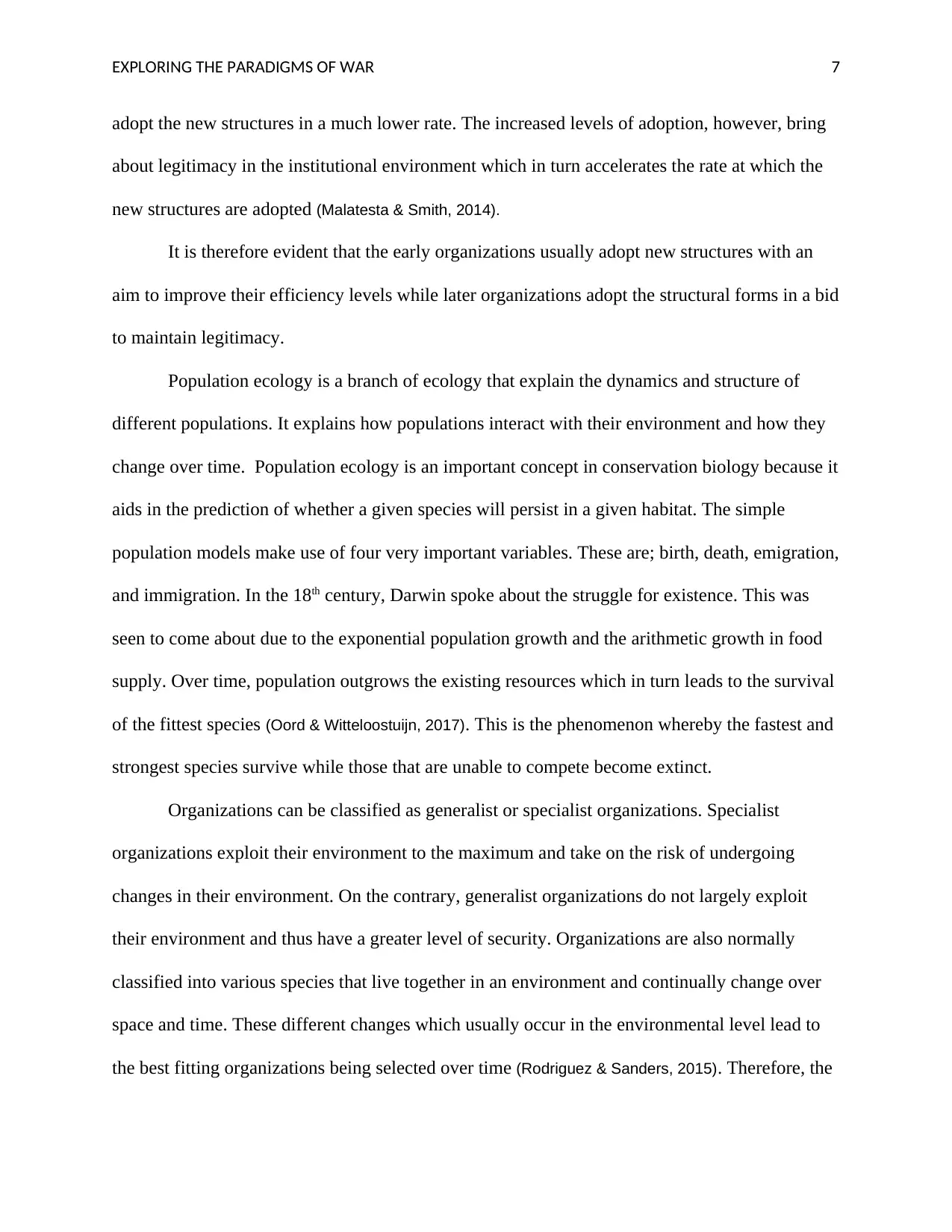
EXPLORING THE PARADIGMS OF WAR 7
adopt the new structures in a much lower rate. The increased levels of adoption, however, bring
about legitimacy in the institutional environment which in turn accelerates the rate at which the
new structures are adopted (Malatesta & Smith, 2014).
It is therefore evident that the early organizations usually adopt new structures with an
aim to improve their efficiency levels while later organizations adopt the structural forms in a bid
to maintain legitimacy.
Population ecology is a branch of ecology that explain the dynamics and structure of
different populations. It explains how populations interact with their environment and how they
change over time. Population ecology is an important concept in conservation biology because it
aids in the prediction of whether a given species will persist in a given habitat. The simple
population models make use of four very important variables. These are; birth, death, emigration,
and immigration. In the 18th century, Darwin spoke about the struggle for existence. This was
seen to come about due to the exponential population growth and the arithmetic growth in food
supply. Over time, population outgrows the existing resources which in turn leads to the survival
of the fittest species (Oord & Witteloostuijn, 2017). This is the phenomenon whereby the fastest and
strongest species survive while those that are unable to compete become extinct.
Organizations can be classified as generalist or specialist organizations. Specialist
organizations exploit their environment to the maximum and take on the risk of undergoing
changes in their environment. On the contrary, generalist organizations do not largely exploit
their environment and thus have a greater level of security. Organizations are also normally
classified into various species that live together in an environment and continually change over
space and time. These different changes which usually occur in the environmental level lead to
the best fitting organizations being selected over time (Rodriguez & Sanders, 2015). Therefore, the
adopt the new structures in a much lower rate. The increased levels of adoption, however, bring
about legitimacy in the institutional environment which in turn accelerates the rate at which the
new structures are adopted (Malatesta & Smith, 2014).
It is therefore evident that the early organizations usually adopt new structures with an
aim to improve their efficiency levels while later organizations adopt the structural forms in a bid
to maintain legitimacy.
Population ecology is a branch of ecology that explain the dynamics and structure of
different populations. It explains how populations interact with their environment and how they
change over time. Population ecology is an important concept in conservation biology because it
aids in the prediction of whether a given species will persist in a given habitat. The simple
population models make use of four very important variables. These are; birth, death, emigration,
and immigration. In the 18th century, Darwin spoke about the struggle for existence. This was
seen to come about due to the exponential population growth and the arithmetic growth in food
supply. Over time, population outgrows the existing resources which in turn leads to the survival
of the fittest species (Oord & Witteloostuijn, 2017). This is the phenomenon whereby the fastest and
strongest species survive while those that are unable to compete become extinct.
Organizations can be classified as generalist or specialist organizations. Specialist
organizations exploit their environment to the maximum and take on the risk of undergoing
changes in their environment. On the contrary, generalist organizations do not largely exploit
their environment and thus have a greater level of security. Organizations are also normally
classified into various species that live together in an environment and continually change over
space and time. These different changes which usually occur in the environmental level lead to
the best fitting organizations being selected over time (Rodriguez & Sanders, 2015). Therefore, the
Paraphrase This Document
Need a fresh take? Get an instant paraphrase of this document with our AI Paraphraser
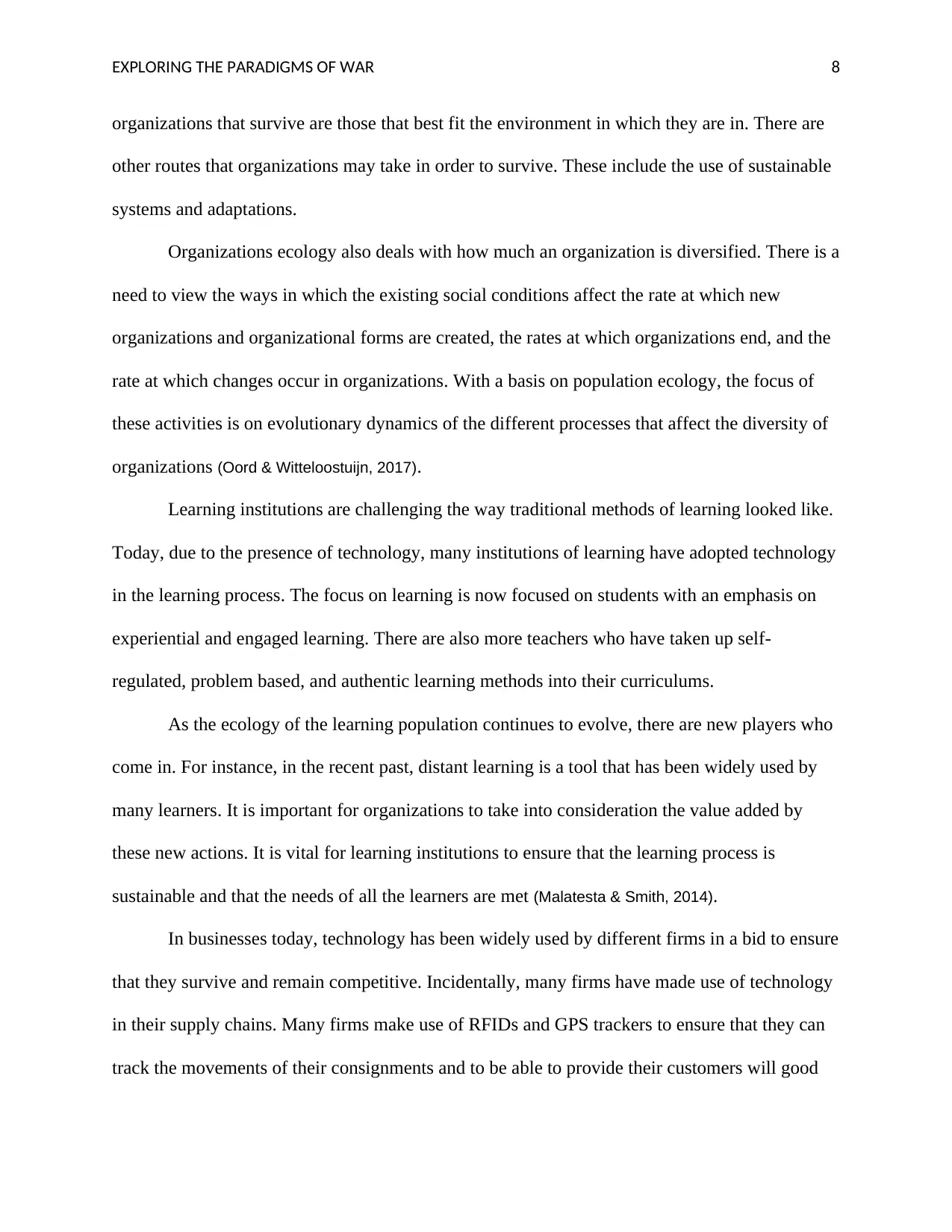
EXPLORING THE PARADIGMS OF WAR 8
organizations that survive are those that best fit the environment in which they are in. There are
other routes that organizations may take in order to survive. These include the use of sustainable
systems and adaptations.
Organizations ecology also deals with how much an organization is diversified. There is a
need to view the ways in which the existing social conditions affect the rate at which new
organizations and organizational forms are created, the rates at which organizations end, and the
rate at which changes occur in organizations. With a basis on population ecology, the focus of
these activities is on evolutionary dynamics of the different processes that affect the diversity of
organizations (Oord & Witteloostuijn, 2017).
Learning institutions are challenging the way traditional methods of learning looked like.
Today, due to the presence of technology, many institutions of learning have adopted technology
in the learning process. The focus on learning is now focused on students with an emphasis on
experiential and engaged learning. There are also more teachers who have taken up self-
regulated, problem based, and authentic learning methods into their curriculums.
As the ecology of the learning population continues to evolve, there are new players who
come in. For instance, in the recent past, distant learning is a tool that has been widely used by
many learners. It is important for organizations to take into consideration the value added by
these new actions. It is vital for learning institutions to ensure that the learning process is
sustainable and that the needs of all the learners are met (Malatesta & Smith, 2014).
In businesses today, technology has been widely used by different firms in a bid to ensure
that they survive and remain competitive. Incidentally, many firms have made use of technology
in their supply chains. Many firms make use of RFIDs and GPS trackers to ensure that they can
track the movements of their consignments and to be able to provide their customers will good
organizations that survive are those that best fit the environment in which they are in. There are
other routes that organizations may take in order to survive. These include the use of sustainable
systems and adaptations.
Organizations ecology also deals with how much an organization is diversified. There is a
need to view the ways in which the existing social conditions affect the rate at which new
organizations and organizational forms are created, the rates at which organizations end, and the
rate at which changes occur in organizations. With a basis on population ecology, the focus of
these activities is on evolutionary dynamics of the different processes that affect the diversity of
organizations (Oord & Witteloostuijn, 2017).
Learning institutions are challenging the way traditional methods of learning looked like.
Today, due to the presence of technology, many institutions of learning have adopted technology
in the learning process. The focus on learning is now focused on students with an emphasis on
experiential and engaged learning. There are also more teachers who have taken up self-
regulated, problem based, and authentic learning methods into their curriculums.
As the ecology of the learning population continues to evolve, there are new players who
come in. For instance, in the recent past, distant learning is a tool that has been widely used by
many learners. It is important for organizations to take into consideration the value added by
these new actions. It is vital for learning institutions to ensure that the learning process is
sustainable and that the needs of all the learners are met (Malatesta & Smith, 2014).
In businesses today, technology has been widely used by different firms in a bid to ensure
that they survive and remain competitive. Incidentally, many firms have made use of technology
in their supply chains. Many firms make use of RFIDs and GPS trackers to ensure that they can
track the movements of their consignments and to be able to provide their customers will good
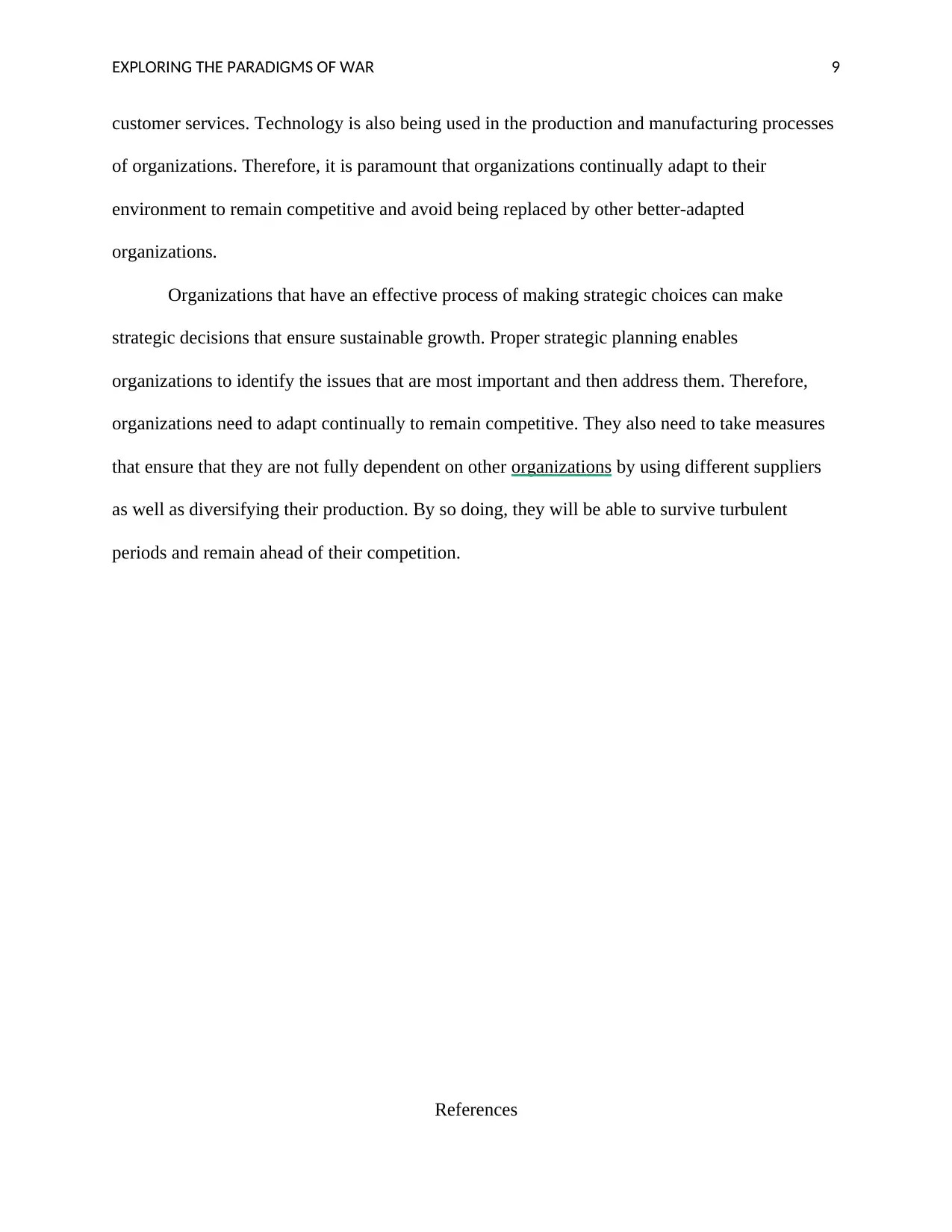
EXPLORING THE PARADIGMS OF WAR 9
customer services. Technology is also being used in the production and manufacturing processes
of organizations. Therefore, it is paramount that organizations continually adapt to their
environment to remain competitive and avoid being replaced by other better-adapted
organizations.
Organizations that have an effective process of making strategic choices can make
strategic decisions that ensure sustainable growth. Proper strategic planning enables
organizations to identify the issues that are most important and then address them. Therefore,
organizations need to adapt continually to remain competitive. They also need to take measures
that ensure that they are not fully dependent on other organizations by using different suppliers
as well as diversifying their production. By so doing, they will be able to survive turbulent
periods and remain ahead of their competition.
References
customer services. Technology is also being used in the production and manufacturing processes
of organizations. Therefore, it is paramount that organizations continually adapt to their
environment to remain competitive and avoid being replaced by other better-adapted
organizations.
Organizations that have an effective process of making strategic choices can make
strategic decisions that ensure sustainable growth. Proper strategic planning enables
organizations to identify the issues that are most important and then address them. Therefore,
organizations need to adapt continually to remain competitive. They also need to take measures
that ensure that they are not fully dependent on other organizations by using different suppliers
as well as diversifying their production. By so doing, they will be able to survive turbulent
periods and remain ahead of their competition.
References

EXPLORING THE PARADIGMS OF WAR 10
Biermann, R., & Harsch, M. (2016). Resource Dependence Theory. Springer Link.
Drees, J., & Heugens, P. (2013). Synthesizing and Extending Resource Dependence Theory A
Meta-Analysis. Journal Of Management; Sage Journals.
Fekadu, K. (2014). The paradox in environmental determinism and possibilism: A literature
review. Journal Of Geography And Regional Planning, 7(7).
Malatesta, D., & Smith, C. (2014). Lessons from Resource Dependence Theory for
Contemporary Public and Nonprofit Management. Wiley Online Library.
Narain, V. (2014). Determinism, Free Will, and Moral Responsibility. The Humanist.Com.
Silvestre, R. (2016). Karma Theory, Determinism, Fatalism and Freedom of Will. Springer
Link, 11(1).
Oord, A., & Witteloostuijn, A. (2017). The Population Ecology of Technology: An Empirical
Study of US Biotechnology Patents from 1976 to 2003.
Rodriguez, A., & Sanders, I. (2015). The role of community and population ecology in applying
mycorrhizal fungi for improved food security. The ISME Journal.
Sahlin-Andersson, K., Greenwood, R., Oliver, C., & Suddaby, R. (2012). Institutional theory in
organization Studies.
Singha, P., Sum, D., & Chuong, C. (2011). A resource dependence theory perspective of ISO
9000 in managing organizational environment. Journal Of Operations
Management, 29(1,2).
Söderberg, J. (2013). Determining social change: The role of technological determinism in the
collective action framing of hackers. New Media & Society; Sage Journals.
Biermann, R., & Harsch, M. (2016). Resource Dependence Theory. Springer Link.
Drees, J., & Heugens, P. (2013). Synthesizing and Extending Resource Dependence Theory A
Meta-Analysis. Journal Of Management; Sage Journals.
Fekadu, K. (2014). The paradox in environmental determinism and possibilism: A literature
review. Journal Of Geography And Regional Planning, 7(7).
Malatesta, D., & Smith, C. (2014). Lessons from Resource Dependence Theory for
Contemporary Public and Nonprofit Management. Wiley Online Library.
Narain, V. (2014). Determinism, Free Will, and Moral Responsibility. The Humanist.Com.
Silvestre, R. (2016). Karma Theory, Determinism, Fatalism and Freedom of Will. Springer
Link, 11(1).
Oord, A., & Witteloostuijn, A. (2017). The Population Ecology of Technology: An Empirical
Study of US Biotechnology Patents from 1976 to 2003.
Rodriguez, A., & Sanders, I. (2015). The role of community and population ecology in applying
mycorrhizal fungi for improved food security. The ISME Journal.
Sahlin-Andersson, K., Greenwood, R., Oliver, C., & Suddaby, R. (2012). Institutional theory in
organization Studies.
Singha, P., Sum, D., & Chuong, C. (2011). A resource dependence theory perspective of ISO
9000 in managing organizational environment. Journal Of Operations
Management, 29(1,2).
Söderberg, J. (2013). Determining social change: The role of technological determinism in the
collective action framing of hackers. New Media & Society; Sage Journals.
1 out of 10
![[object Object]](/_next/static/media/star-bottom.7253800d.svg)




